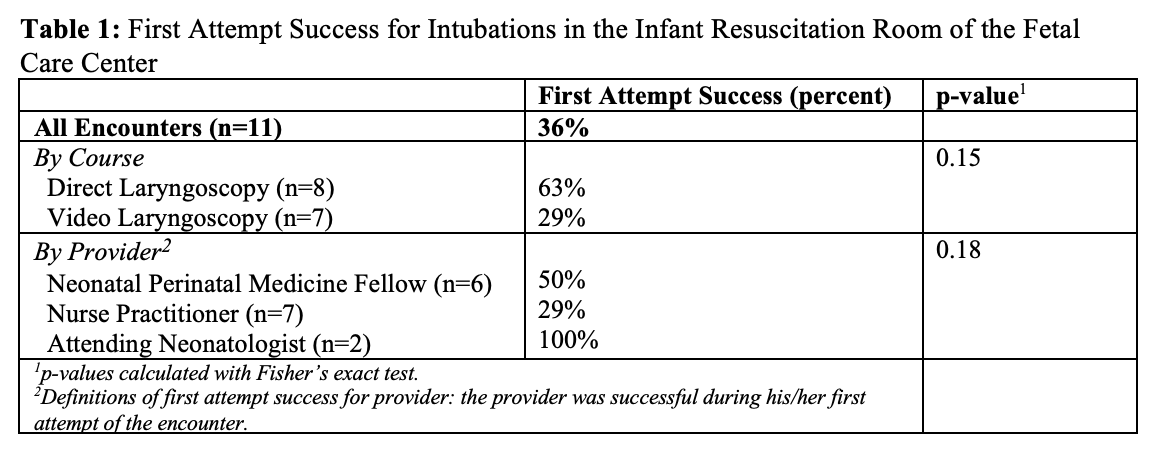Neonatology
Session: Neonatal/Infant Resuscitation 1
262 - Video Review Enhances Recognition of Intubation Attempt Duration and Success in Fetal Care Center Delivery Room Resuscitations
Monday, May 6, 2024
9:30 AM - 11:30 AM ET
Poster Number: 262
Publication Number: 262.3112
Publication Number: 262.3112

Morgan E. Hill, MD (she/her/hers)
Assistant Professor of Pediatrics, Division of Neonatology
Cincinnati Children's Hospital Medical Center
Loveland, Ohio, United States
Presenting Author(s)
Background: Fetal care centers (FCC) offer comprehensive care from prenatal diagnosis to postnatal management and may provide delivery room management of infants with complex diagnoses. The resuscitation team must be capable of executing Neonatal Resuscitation Program (NRP), including performing intubation, for these complex patients. NRP recommends the steps of intubation be completed within 30 seconds. The National Emergency Airway Registry for Neonates (NEAR4NEOS) reports 46% first attempt success rate in the delivery room. There is lack of awareness surrounding duration and success of intubation attempts during delivery room resuscitations in our FCC. Video review (VR) has been proven useful as a tool to evaluate compliance with NRP and provide valuable educational experience.
Objective: We sought to utilize VR to determine duration of intubation attempts and first attempt success rate for this complex population.
Design/Methods: A VR program was established for our FCC in November 2022. Recordings are generated for resuscitations in the Infant Resuscitation Room (Figure 1). Recordings were analyzed and intubation data was collected. Intubation encounter, course, and attempt were defined as per NEAR4NEOS. Duration of intubation attempt was defined as time from laryngoscope blade entering the mouth until removal of laryngoscope. A successful intubation was defined as placement of endotracheal tube in the trachea confirmed by colorimetric CO2 detector.
Results: Sixty-nine recordings were generated for 69 unique neonatal deliveries from November 2022 to September 2023; 42 neonates (61%) required resuscitation and 11 neonates (16%) required intubation. There were 23 total intubation attempts across these 11 intubation encounters with a 36% first attempt success rate (Table 1). Intubation attempts averaged 68 seconds; median time 61 seconds (Table 2). Successful attempts averaged 57 seconds; unsuccessful attempts averaged 78 seconds (p=0.14).
Conclusion(s): The FCC VR program allows for objective evaluation of intubation performance. Our current intubation attempts are longer than recommended as per NRP and less successful than reported in the literature, particularly for trainees and when using video laryngoscopy. Given known association of increased duration and number of attempts with adverse tracheal intubation associated events, this may significantly impact patient outcomes. Quality improvement efforts are being developed to decrease median duration of intubation attempts from 61 to 30 seconds, with a focus on trainees and video laryngoscopy proficiency.
.png)


